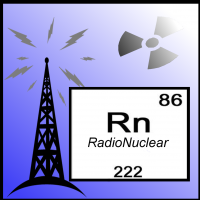Focus on Ukraine

We’ve sifted through facts and statistics on nuclear power in Ukraine to offer some choice insights here. Want more international nuclear data? Check out the March 2022 Nuclear News Reference Issue.

A message from Goodway
Dry Ice Blasting: A Game-Changer for Safe Cleaning and Decontamination in Nuclear Power Plants

We’ve sifted through facts and statistics on nuclear power in Ukraine to offer some choice insights here. Want more international nuclear data? Check out the March 2022 Nuclear News Reference Issue.

This is the third of five articles to be posted today to look back at the top news stories of 2021 for the nuclear community. The full article, "Looking back at 2021,"was published in the January 2022 issue of Nuclear News.
Quite a year was 2021. In the following stories, we have compiled what we feel are the past year’s top news stories from the April-June time frame—please enjoy this recap from a busy year in the nuclear community.

After 45 years of producing electricity, the first unit at Russia’s Kursk nuclear power plant has been retired, plant operator Rosenergoatom announced on Monday. Kursk I-1, one of the facility’s four 925-MWe light water–cooled graphite-moderated reactors, model RBMK-1000 (a Chernobyl-type reactor), was permanently shut down at 00:24 Moscow time on December 19.

Bryukhanov
Viktor Bryukhanov, the man blamed for the Chernobyl disaster, has died at age 85.
Bryukhanov was in charge of the Chernobyl plant in Ukraine when the devastating accident occurred in 1986. Afterward, he was held responsible and was imprisoned.
Bryukhanov's death, on October 13 in Kiev, Ukraine, was announced by a representative of the now-closed nuclear plant, according to a report in the New York Times. He had suffered from Parkinson’s disease, in addition to having had several strokes following his retirement in 2015.
The sentencing: In 1987, Bryukhanov was found guilty of gross violation of safety regulations, creating conditions that led to the steam explosion that released a radioactive dust cloud into the atmosphere. Reports also mentioned that he failed to ensure correct and firm leadership in the difficult conditions of the accident and displayed irresponsibility and inability to organize. He was sentenced to 10 years in a labor camp along with a five-year sentence for abuse of power, which ran concurrently.

A team of scientists from the United Kingdom’s University of Bristol were given access to the Chernobyl nuclear power plant in Ukraine, advancing a project to train robots and artificial intelligence systems to measure radiation and create 3D maps.
A slideshow of the team’s visit to Chernobyl’s Unit 4 control room and New Safe Confinement structure, where they deployed radiation mapping and scanning sensors, including a LIDAR-equipped robot call Rooster, appears on Gizmodo.

DISCLAIMER: The views expressed in posted articles do not necessarily reflect the views of the American Nuclear Society. The views expressed here are those of the individual authors. ANS takes no ownership of their views. The American Nuclear Society assumes no responsibility or liability for any use or operation of any methods, products, instructions, or ideas contained on this site.
It is hard to get anyone to agree on anything these days. However, it’s pretty safe to say that most of us want clean air to breathe and adequate energy supplies. It is difficult to see any current or proposed energy policy that brings us closer to that goal. In fact, over the past 15 years, we have not put a dent in our “carbon footprint,” despite the proliferation of “renewable energy” supported by staggeringly large subsidies. What is really puzzling, however, is the huge amount of subsidy money going toward fossil fuels when we are told that these have to be gone completely by the year 2050. Of $18.4 billion dollars in subsidies in 2016, 59 percent went to renewables, 25 percent went to fossil fuels, and 15 percent went to “energy efficiency.”

No matter the discipline, reporting on technical issues for a mass audience is fraught with pitfalls. To make the subject understandable to the layperson, authors make generous use of analogies, which are inherently incomplete and tenuous, like a stone house being built on swampland.
Likewise, in an effort to garner as many clicks or views as possible, reporters and news outlets will often resort to sensationalism, making the news being reported more dramatic than it is. (To be fair, those supplying the news can also be guilty of sensationalism in their hunger for media coverage.)

Climate activists rarely mention nuclear power as a tool in the battle against climate change, consumer reporter John Stossel comments during the video "The Nuclear Option" on his YouTube channel.

Ukraine’s State Nuclear Regulatory Inspectorate (SNRIU) has authorized the operation of Chernobyl’s Interim Storage Facility (ISF-2), allowing spent nuclear fuel from the plant’s three undamaged reactors to be loaded into the dry storage facility. The handover of the ISF-2 operating license was carried out during a ceremony held on April 26, the 35th anniversary of the Chernobyl accident, and was attended by Ukraine’s president, Volodymyr Zelensky.

An atomic safety and licensing board has been established to address a hearing request filed on behalf of an antinuclear group regarding the subsequent license renewal (SLR) application for NextEra Energy’s Point Beach reactors, located near Two Rivers, Wis. The Nuclear Regulatory Commission published notice of the panel’s formation in the April 2 Federal Register.

Rowlatt
Following U.K. Prime Minister Boris Johnson’s recent restatement of the United Kingdom’s commitment to nuclear power, BBC News chief environment correspondent, Justin Rowlatt, wrote an article aimed at separating fact from fiction regarding the safety and benefits of nuclear energy.
Among his points, Rowlatt defended the use of nuclear power to combat climate change, examined the data behind deaths from radiation exposure directly caused by the Chernobyl and Fukushima accidents, and explained that exposure to low levels of radiation is not a major health risk.
The Bulletin of the Atomic Scientists (BAS) is currently featuring on its website a series of five articles by young American and Russian scholars on nuclear safety, with a focus on the industry’s three major accidents: Three Mile Island, Chernobyl, and Fukushima.
In one of those articles, “Don’t let nuclear accidents scare you away from nuclear power,” the authors conclude that “even after accounting for both the immediate and long-term toll of the three accidents, nuclear power has a remarkably safe track record compared to coal, natural gas, and even hydroelectric power.”
Philippine President Rodrigo Duterte on July 24 signed an executive order that calls for a study to determine the feasibility of introducing nuclear energy into the country’s power generation mix. Citing “the experience of a number of countries” showing nuclear power to be “a reliable, cost-competitive, and environment-friendly energy source,” the order creates the Nuclear Energy Program Inter-Agency Committee (NEP-IAC) to carry out the work.
A forest fire near the Chernobyl site had no effect on radiation levels in the exclusion and evacuation zones around the site, according to the State Emergency Service of Ukraine (SESU) on April 8. The “equivalent dose rates of gamma radiation did not change,” SESU stated.
SESU’s statement came three days after Egor Firsov, the head of Ukraine’s ecological inspection service, wrote in an online post, “There is bad news---in the center of the fire, radiation is above normal.” On a video that accompanied the post, Firsov displayed a Geiger counter that showed elevated levels of radiation.
I just knew it! I was hoping I'd be wrong, that HBO would have the courage and integrity to do their homework and consult even one actual nuclear scientist or radiobiologist. Or even just read the United Nations Chernobyl Forum Report, the best source of information on the disaster for non-nuclear people.
Episode 22 of RadioNuclear is now available. In this episode, we discuss the recent miniseries "Chernobyl", which recently concluded on HBO. We debunk some of the more egregious articles written in the wake of the show (see links to these articles below). We also discuss good ways to engage with individuals who are captivated with the show, and not necessarily familiar with nuclear technology.
 Welcome to the New Year! Even though I am on the road, there is just so much happening lately in nuclear I could not pass up the opportunity to talk about it! This episode of RadioNuclear, we take a look at recent and exciting legislation and policy for advanced nuclear. This includes the passages of the NEIMA and NEICA bills and what the Idaho National Laboratory may look like in the coming years. We also discuss the NRC's recent decision on post Fukushima regulation. Lastly, we look on how you can adopt a dog from the Chernobyl exclusion zone. No, I am not making that up!
Welcome to the New Year! Even though I am on the road, there is just so much happening lately in nuclear I could not pass up the opportunity to talk about it! This episode of RadioNuclear, we take a look at recent and exciting legislation and policy for advanced nuclear. This includes the passages of the NEIMA and NEICA bills and what the Idaho National Laboratory may look like in the coming years. We also discuss the NRC's recent decision on post Fukushima regulation. Lastly, we look on how you can adopt a dog from the Chernobyl exclusion zone. No, I am not making that up!

Courtesy SSE ChNPP.
In the administration building of the Chernobyl nuclear power plant, a number of stained glass windows (as seen to the right) recall the optimistic tone of industrial Soviet-era art that can still be viewed today at power plants around the former USSR. That these are well preserved is not the result of a specific effort, but instead because of the essential abandonment of large parts of the facility, and even the entire region, after the most serious nuclear reactor accident in 1986 in history.
![tr-senate[1]](https://cdn.ans.org/cafe/2011/08/tr-senate16.jpg)
Rockwell
Facts vs. myths about the health effects of Fukushima and Chernobyl. The conclusions of scientists studying health consequences may be startling to those exposed only to commonly held beliefs and traditional media (and Chernobyl Diaries!)